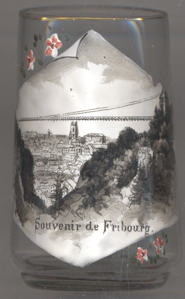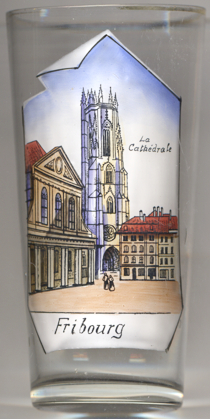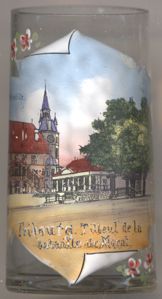

|
| SCHWEIZ / SUISSE / SVIZZERA / SVIZRA | SWITZERLAND |
| Freiburg / Fribourg / Friborgo / Friburg |
Fribourg (French) or Freiburg (German; also Freiburg im Üechtland) (Italian: Firburgo or Friborgo, Romansh: Friburg), is the capital of the Swiss canton of Fribourg and the district La Sarine (German: Saanebezirk). It is located on both sides of the river Sarine/Saane, on the Swiss Plateau, and is a major economic, administrative and educational center on the cultural border between German and French Switzerland (Romandy). Its Old City, one of the best-maintained in Switzerland, sits on a small rocky hill above the valley of the Sarine. The municipality has a population of about 38,800 (2016).
The town was founded in 1157 by Berthold IV, Duke of Zähringen. Its name is derived from German frei (free) and Burg (fort). The easily defended city helped the dukes to strengthen and extend their power in the Swiss plateau in the area between the Aare and La Sarine. Beginning at the time of its inception, Fribourg built a city-state; initially, the land it controlled lay some distance away. When the dukes of Zähringen died out in 1218, the city came came in possession of the related Kyburg family. They granted the city its former privileges and wrote the municipal laws in the so-called Handfeste in 1249, in which the legal, institutional and economic organizations were established. Several treaties with neighbouring city-states, including Avenches (1239), Berne (1243), and Morat (Murten) (1245), were signed at this time. The city was sold to the Habsburgs in 1277. Trade and industry began as early as the mid-13th century. The 14th century was dominated by trade, and cloth and leather production, which brought the city renown in Central Europe by 1370. The treaty with Bern was renewed in 1403. The leaders of the city began a territorial acquisition, in which they gradually brought more nearby land under their control. This laid the ground-work for the canton of Fribourg. By 1442 the city had control of all the land within about 20 kilometres on both sides of the Saane. The mid-15th century was shaped by various military conflicts. The Savoyard influence on the city grew, and the Habsburgs ceded it to them in 1452. It remained under the control of Savoy until the Burgundian Wars in 1477. After the city was released from the sphere of influence of Savoy, it attained the status of Free Imperial City in 1478. The city and its canton joined the Swiss Confederation in 1481. In the 16th century, Fribourg continued to grow, first following the invasion of Waadtland (Pays de Vaud) in 1536 with the help of Bern, and then in 1554 through the annexation of land formerly controlled by the Count of Greyerz (Gruyère). An important milestone for the politics of the city was reached in 1627, when the patricians drew up a new constitution, taking control of all voting rights. This consolidated the oligarchy which had begun to form as early as the 15th century. In 1613 Fribourg became the seat of the Bishop of Lausanne, who, after the Reformation, was forced first into Evian, and then into exile in Burgundy. Today it is the seat of the Diocese of Lausanne, Geneva and Fribourg. The invasion of Switzerland by French troops in 1798 lead to the downfall of this Ancien Régime. With the introduction of the Act of Mediation under Napoleon in 1803, the separation of the city of Fribourg from its canton was finally carried out. Fribourg was made the capital of its region and canton, and, between 1803 and 1809, was one of the capitals of Switzerland. The patricians regained control of the city in 1814 during the Restoration period and ruled until 1830. Fribourg was part of the 1845–1847 Sonderbund, a "separate alliance" of Catholic cantons attempting to secede from Switzerland, however Fribourg and the Sonderbund finally capitulated to Federalist forces on 14 November 1847. In 1848 the city wall was partially torn down and a new bridge constructed across the Saane/La Sarine. The opening of the midland railway line through the city in 1862 enabled Fribourg to undergo industrialisation. The university of Fribourg was inaugurated in 1889.

The  Grand Pont [foreground] (German: Zähringerbrücke,
'Zähringen Bridge') was built in 1832–1834 to connect the inner city of Fribourg with the right bank of the Sarine.
The bridge was designed by the French engineer Joseph Chaley. With a single suspension of 273 m it was the world's
longest suspension bridge at the time of its opening (it was only surpassed in 1849 by the Wheeling Suspension Bridge with a
suspension of 308 m). In 1881 the bridge was reinforced by two additional suspension cables. However, corrosion of
the suspension cables and insufficient rigidity of the wooden carriageway construction at the beginning of the 1920s
required the construction of an entirely new bridge. The new bridge, a stone arch construction with seven arches of 30 m
each, was opened in 1924. Since the opening in 2014 of the Pont de la Poya, the Grand Pont is closed to private car traffic.
Grand Pont [foreground] (German: Zähringerbrücke,
'Zähringen Bridge') was built in 1832–1834 to connect the inner city of Fribourg with the right bank of the Sarine.
The bridge was designed by the French engineer Joseph Chaley. With a single suspension of 273 m it was the world's
longest suspension bridge at the time of its opening (it was only surpassed in 1849 by the Wheeling Suspension Bridge with a
suspension of 308 m). In 1881 the bridge was reinforced by two additional suspension cables. However, corrosion of
the suspension cables and insufficient rigidity of the wooden carriageway construction at the beginning of the 1920s
required the construction of an entirely new bridge. The new bridge, a stone arch construction with seven arches of 30 m
each, was opened in 1924. Since the opening in 2014 of the Pont de la Poya, the Grand Pont is closed to private car traffic.

The  Cathédrale Saint-Nicolas [near left, no. 4646: background] was built from 1283 in
several stages until 1490 on the site of a previous, Romanesque church. The three-aisled Gothic church has a 74-meter-high tower, which was completed
in 1490 in the style of late Flamboyant gothic. Until 1924 it was the church of a collegiate minster. Since 1924 it is the seat of the catholic bishop
of Lausanne, Genève and Fribourg.
Cathédrale Saint-Nicolas [near left, no. 4646: background] was built from 1283 in
several stages until 1490 on the site of a previous, Romanesque church. The three-aisled Gothic church has a 74-meter-high tower, which was completed
in 1490 in the style of late Flamboyant gothic. Until 1924 it was the church of a collegiate minster. Since 1924 it is the seat of the catholic bishop
of Lausanne, Genève and Fribourg.
The  Basilica Notre-Dame [near left, no. 4646: left] is the oldest church in Fribourg. It goes back
to a church that was built in Romanesque style in the 12th century. The western façade and the interior were remodeled in Baroque and Classicist
style in 1785–1787. The church, which belongs to the Catholic diocese of Lausanne, Geneva and Fribourg, was elevated to the rank of Basilica minor
in 1932.
Basilica Notre-Dame [near left, no. 4646: left] is the oldest church in Fribourg. It goes back
to a church that was built in Romanesque style in the 12th century. The western façade and the interior were remodeled in Baroque and Classicist
style in 1785–1787. The church, which belongs to the Catholic diocese of Lausanne, Geneva and Fribourg, was elevated to the rank of Basilica minor
in 1932.

Glass no. 4292 [near left] shows a view of  La Basse Ville (in German: Unterstadt),
the old town at the river Sarine/Saane.
La Basse Ville (in German: Unterstadt),
the old town at the river Sarine/Saane.

The  town hall (Hôtel de Ville) [left, no. 4472: left]
was built in 1501–1522 in place of the former castle that had been destroyed in the 15th century. Its clock tower was altered
several times during in the 16th and 17th century.
town hall (Hôtel de Ville) [left, no. 4472: left]
was built in 1501–1522 in place of the former castle that had been destroyed in the 15th century. Its clock tower was altered
several times during in the 16th and 17th century.
The  linden tree of the Battle of Murten (Tilleul de la Bataille de Morat) [left, no. 4472: right]
commemorates the victory of the Confederates in the Battle of Murten/Morat in 1476 against the French. According to the popular legend, a
runner ran the route from Murten to Friborg to bring the news of the victory, waving a linden branch that he had torn off a tree on the
battlefield. At the site where the runner collapsed, a new tree is said to have grown from the branch. The linden tree grew quickly and had
very dense leaves. Soon walls had to be built to support the lower branches.
linden tree of the Battle of Murten (Tilleul de la Bataille de Morat) [left, no. 4472: right]
commemorates the victory of the Confederates in the Battle of Murten/Morat in 1476 against the French. According to the popular legend, a
runner ran the route from Murten to Friborg to bring the news of the victory, waving a linden branch that he had torn off a tree on the
battlefield. At the site where the runner collapsed, a new tree is said to have grown from the branch. The linden tree grew quickly and had
very dense leaves. Soon walls had to be built to support the lower branches.
Other glasses of this collection show views of Freiburg im Breisgau, Germany.
[https://de.wikipedia.org/wiki/Freiburg_im_Üechtland, https://en.wikipedia.org/wiki/Fribourg;
https://de.wikipedia.org/wiki/Zähringerbrücke;
https://de.wikipedia.org/wiki/St._Nikolaus_(Freiburg_im_üechtland);
https://de.wikipedia.org/wiki/Notre-Dame_(Freiburg)
https://www.morat-fribourg.ch/presentation/die-geschichte-des-murtenlaufes/?lang=de]
![[scale]](lineal.jpg)